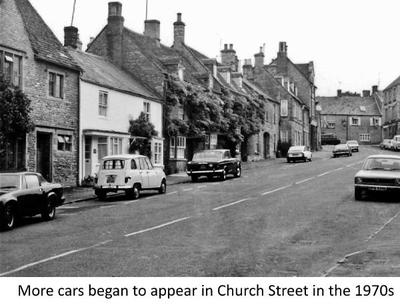
The History of Charlbury through ....the arrival of the motor car
Following the recent Town Council traffic survey, it seems topical to look at the dramatic changes wrought by motor vehicles over the last century. Before that road transport consisted mostly of horse-drawn vehicles and bicycles. From the early 1900s cars began to increase much to the consternation of walkers. A Charlbury Parish Council meeting in 1912 noted the need to improve the footpaths as “… now owing to the motorists it was dangerous for pedestrians on the highway. The Chairman said he thought too much money was being spent on the highways at the present time simply to make them motor tracks.” The following year a petition was sent to the County Council complaining of “the dust nuisance caused by the increasing motor traffic through the streets of the town and asking that the streets may be treated with tar paint.”
The rise in motor vehicles is reflected in increasingly frequent reports of accidents in the Oxford Times. On 20 September 1913 Mr F. Harwood of Lees Rest Farm and his wife were motoring home when they collided with another car at the Five Ways junction, described as “the very dangerous blind crossroads”. Fortunately no one was injured but both cars were seriously damaged. Mr Harwood must have felt very out of luck – two ricks at the farm had burnt down the evening before in a major fire.
Motorbikes became increasingly popular, appealing particularly to young men who were increasingly involved in accidents. In 1926 Harold Warner of Market Street, a popular local footballer player, collided with a pedestrian near the Bladon turn as he returned from a match. He sustained severe head injuries but luckily survived, unlike the pedestrian who later died in hospital.
Local garages began to open. By 1914 Warners in Market Street looked after the few cars in Charlbury, and Claydons at Home Farm on the Playing Close repaired cars and agricultural vehicles. By 1926 Frank Widdows ran the Station Hill Garage on Dyers Hill, and Brice and Price opened next to the Baptist Church. Warners were later taken over by Morrisons: when Noahs Ark was converted into an office in the early 2000s, an oil sump was found still under the floor. Wearings in Sheep Street repaired cars and also ran frequent bus services, as did Phillips in Nine Acres Lane.
Private car ownership took off in the 50s, and in the 60s houses began to be built with garages (e.g the bungalows in Sandford Rise) though few can accommodate a modern car. The first motorists would be staggered by the thousands of traffic movements each day through the town. It will be interesting and no doubt sobering to learn the results of the recent survey.
All quotes taken from newspaper reports in The Oxford Times, available in the museum.
We will look at the bus services which served the town in a later posting.







